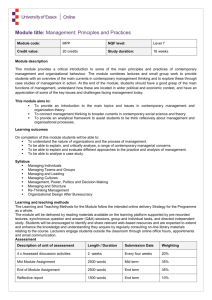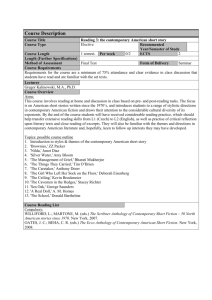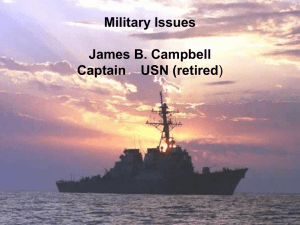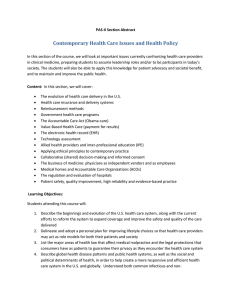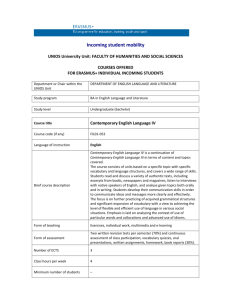Colloquium Brief
advertisement
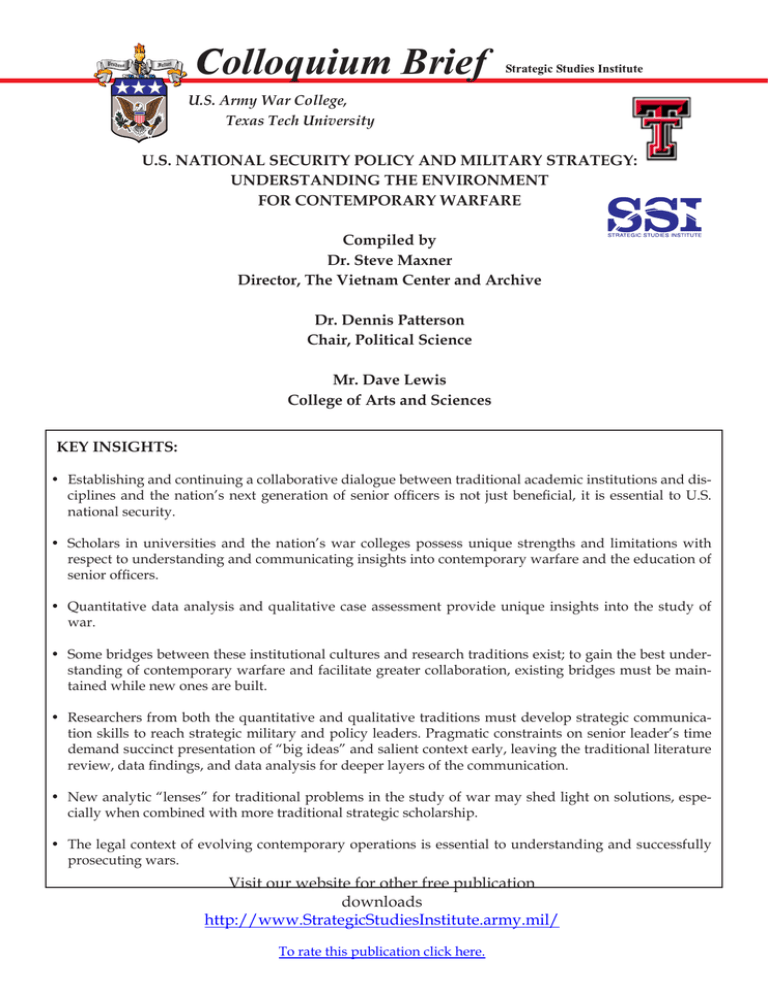
Colloquium Brief U.S. Army War College, Texas Tech University U.S. NATIONAL SECURITY POLICY AND MILITARY STRATEGY: UNDERSTANDING THE ENVIRONMENT FOR CONTEMPORARY WARFARE Compiled by Dr. Steve Maxner Director, The Vietnam Center and Archive Dr. Dennis Patterson Chair, Political Science Mr. Dave Lewis College of Arts and Sciences KEY INSIGHTS: • E stablishing and continuing a collaborative dialogue between traditional academic institutions and disciplines and the nation’s next generation of senior officers is not just beneficial, it is essential to U.S. national security. • S cholars in universities and the nation’s war colleges possess unique strengths and limitations with respect to understanding and communicating insights into contemporary warfare and the education of senior officers. • Q uantitative data analysis and qualitative case assessment provide unique insights into the study of war. • S ome bridges between these institutional cultures and research traditions exist; to gain the best understanding of contemporary warfare and facilitate greater collaboration, existing bridges must be maintained while new ones are built. • R esearchers from both the quantitative and qualitative traditions must develop strategic communication skills to reach strategic military and policy leaders. Pragmatic constraints on senior leader’s time demand succinct presentation of “big ideas” and salient context early, leaving the traditional literature review, data findings, and data analysis for deeper layers of the communication. • N ew analytic “lenses” for traditional problems in the study of war may shed light on solutions, especially when combined with more traditional strategic scholarship. • T he legal context of evolving contemporary operations is essential to understanding and successfully prosecuting wars. Visit our website for other free publication downloads http://www.StrategicStudiesInstitute.army.mil/ To rate this publication click here. collect data on instances of terrorism. These data sets are often used in academic studies of international conflict, but they are rarely used in the professional military education of senior officers. The different types of data available, and potential uses of such data were the topic of the colloquium’s second panel. In that session, Dr. Laura Dugan of the University of Maryland explained how to access the Terrorism Database and discussed the content of that database so that its usefulness could be clearly understood. Dr. Kim Elliot talked about the sanctions database that she and her colleagues at the Peterson Institute for International Economics created, and Dr. Paul Hensel described the availability of three interstate conflict databases, how they are structured, and how they could be tapped for education and training purposes. Introduction. No problem facing the United States is more important than national security, particularly in the context of our contemporary wars. In addition, no institution is more involved and more affected by this problem of protecting national security in the context of contemporary wars than the U.S. Army (and the U.S. military overall). The problem of contemporary wars has created numerous challenges for the U.S. Army. Through an active academic outreach program, of which this colloquium with Texas Tech University, the Vietnam Center and Archive, and the Department of Political Science was part, many perspectives and methodologies can be brought to bear on these problems. The purpose of this collaboration is to begin a dialogue that can help bridge the gap between two worlds, one where senior U.S. military officers are educated and the other where scholars work on problems that relate to the causes and conduct of war. To help bridge this gap, Texas Tech University proposed to bring together two traditions of research that as a rule do not collaborate. The first is the case-rich, historical tradition of military scholarship. This is an important tradition and an essential part of the academic education of senior officers. However, because it is case based, it is limited in terms of generalizability. To address this limitation, the colloquium proposed to explore how a case-based academic tradition could be married to a quantitative study of warfare, which is practiced in several liberal arts political and social science departments. The reference here is to large-N quantitative studies of interstate conflict, sanctions, and terrorism. Such quantitative studies began in 1963 with the Correlates of War Project (COW) at the University of Michigan. Since the initial COW data collection effort began, other data sets were established that: 1) expanded the definition of interstate conflict from formally declared to all militarized interstate disputes; 2) included all cases of single and multiple states imposing economic sanctions on other countries for explicit political and economic purposes; and 3) initiated efforts to Day 1. This colloquium’s first panel was intended to set the stage for the kind of collaboration that could take place between two institutional cultures, the U.S. military education institutions (the U.S. Army War College) and civilian academic institutions (Departments of Political Science). This first session highlighted and contrasted the strengths that academics and senior members of the military bring to the process of educating the next generation of senior officers and highlighted areas where collaboration could take place. A discussion followed using an illustrative Middle East case as an example of how collaboration between the two institutional types might benefit both. Finally, Dr. Carlton Phillips, a specialist in bioterrorism at Texas Tech University, discussed his area of expertise, treating it as an area where a bridge already exists between academia and the U.S. military. The discussion prompted by these presentations was a perfect prelude to the afternoon sessions which began with a discussion of the importance of case analysis in military education. All papers on this panel were quite detailed and informative and, as such, they made the case that in-depth analyses are essential if we are to under- 2 stand the environment of contemporary warfare. At the same time, these presentations raised the issue of generalizability, not so much the criticism that single cases are not generalizable, but more importantly that those conducting case analysis should think about the problems they are investigating in a way that helps one identify potentially generalizable lessons derived from multiple individual cases. This panel was followed by a session where the actual benefits of collaboration were addressed by three speakers who viewed such benefits from different perspectives. The first perspective was that of a senior military leader’s gatekeeper. This view emphasized the time constraints facing senior decisionmakers. These constraints require researchers to carefully package and present material in increasingly detailed layers, if they are to reach and have an impact on their intended audience. The first layer must rapidly present the essential ideas, and reinforce their relevance by briefly placing the key points in context. Subsequent layers can provide traditional data findings and analysis; but without the relevant content prominently and clearly presented up-front, the rest will not have purchase. A second perspective focused on the constraints associated with collaboration. This perspective was informed by an educator facing the imperative of having to cover certain cases in-depth, while acknowledging the potential benefit of being able to generalize across many cases using large-N data sets. This session was closed with a talk on the possibilities offered by using the most cutting edge technology to advance the research and training efforts currently underway. studies with regard to will and war. The second presentation demonstrated the use of quantitative methodologies for understanding how nonstate actors fight and defeat states in war. Finally, the last presentation highlighted the need for the use of strategic communication as a counterterrorist tool. The subsequent panel was quite unique in that it viewed the challenges of contemporary warfare through the lens of international law and associated legal issues involved in conducting today’s wars. Traditional views of Just War and the Law of Armed Conflict were reviewed by the first panelist. The second panelist explored some unique contemporary challenges, introducing the concept of “Lawfare”; specifically, relating the concept to legal challenges associated with captured personnel and their status. The third panelist examined the legal challenges posed by the use of drones in prosecuting our current wars. Conclusion. The culminating session was designed to pull together all the ideas and information presented previously with an eye to continuing the dialogue and setting the agenda for future collaboration. We acknowledge that the U.S. Army War College and Texas Tech University are institutions that very often speak different languages and that spanning that discourse gap will take deliberate effort on the part of both parties. This final session heard opinions that such a gap can be bridged not only by seeking a common language, but also by acknowledging that both institutions are working on a common set of problems; problems associated with the best way to win at war in the context of the contemporary security environment. Similarly, it is often true that those who do case-study (qualitative) research do not speak the same language as those who do large-N quantitative studies. This does not prevent these institutional cultures (military/civilian) and research traditions (quantitative/qualitative) from finding common ground. As long as researchers from each culture and tradition present their contribution in terms of a common understanding of Day 2. The second day of the colloquium started with a panel that examined some new “lenses” for viewing the challenges of contemporary warfare. The first presentation focused on the Clausewitzian notion of means and will in war. It outlined a framework for comprehending the complex interactions that exist between means and will, and it issued a challenge for quantitative 3 the problem of national security in the context of contemporary warfare, such an interactive conversation can take place. This mutually beneficial collaborative prospect can only be achieved when each stakeholder describes their unique contribution to the broader scope and more robust environment in which problems of contemporary warfare are understood. Overall, in spite of the fact that different actors will address this problem through different sets of expertise, the key to bridging the communication gap is to maintain focus on the common problem, while providing insight into how the research approach highlights a unique aspect of the problem or context within the broader field of study. The search for greater understanding through bridging communications makes the continuation of the dialogue initiated at this conference essential. ***** The views expressed in this brief are those of the authors and do not necessarily reflect the official policy or position of the Department of the Army, the Department of Defense, or the U.S. Government. ***** More information on the Strategic Studies Institute’s programs may be found on the Institute’s homepage at: www.StrategicStudiesInstitute.army.mil. 4
